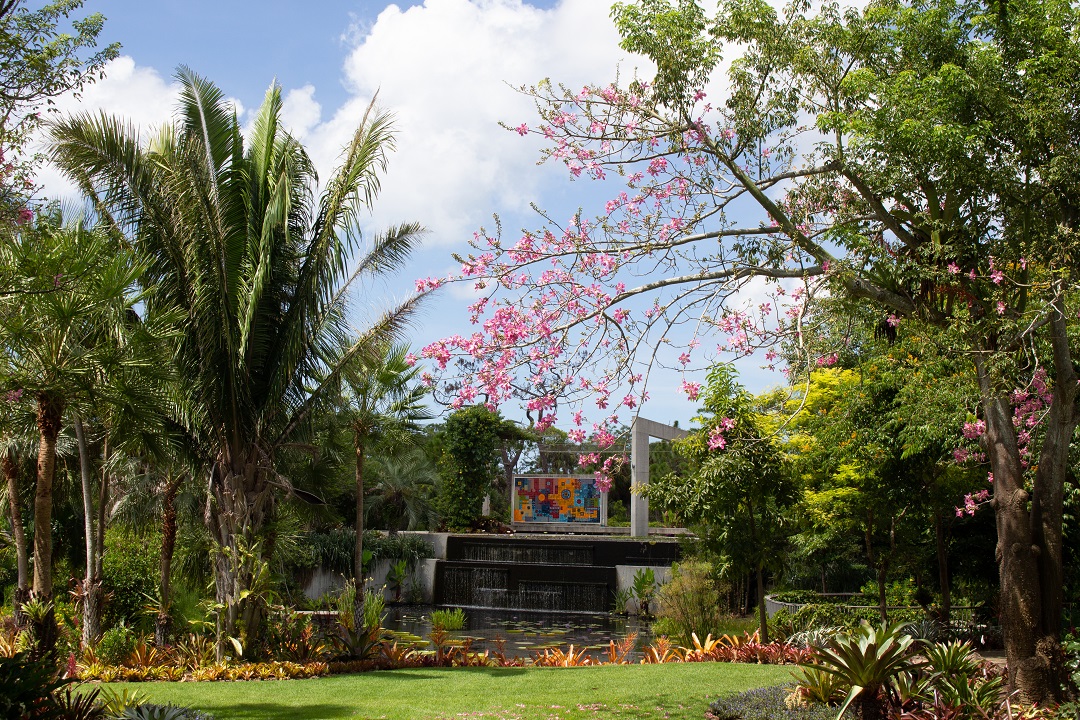
Can you study biography through botany?
We like to think so, and a package arrived not too long ago to prove that point. In it were cuttings and rhizomes of Begonias, a family of plants known for its seemingly endless array of shapes, colors, patterns, and blooms.
These are a special subset of Begonia. They are species that the famed Brazilian landscape architect Roberto Burle Marx (1909 – 1994) had used in his pioneering designs. Our Kapnick Brazilian Garden was designed by Raymond Jungles, a Burle Marx protégé who channeled his mentor in creating our garden.
“Look at this one,” invites Liz Chehayl, the Brian Holley Curator of Collections, pointing to a Begonia plantanifolia leaf with a pinkish underside. She had researched the Begonias that Burle Marx favored and asked our partners at Fort Worth Botanic Garden to send cuttings. Fort Worth has North America’s largest Begonia collection and recently began sharing its plants so that we can back them up.

The arrival of the Begonias gives us good reason to look back on Burle Marx’s life and influence on landscape design and how he redefined Brazilians’ relationship with the natural world.
When Burle Marx started designing, most Brazilian landscapes mimicked a formal, European style and used European plants. He saw beauty in Brazil’s native species, especially those in the country’s less-developed northeast, his mother’s birthplace. Burle Marx ventured into natural areas and brought back plants from the wild to use in his designs and to introduce to his fellow Brazilians.
Eventually, Burle Marx started his own nursery because no one else was growing the plants he wanted to use. (Incidentally, the Garden hopes to do the same in coming years with South Florida and Caribbean native plants, which can be difficult to find in the commercial trade but add ecological and aesthetic value to the landscape.)

At least 20 plants are named for Burle Marx. Two of them, Ctenanthe burle-marxii and Goeppertia (formerly Calathea) burle-marxii, are in the Brazilian Garden. Others, like Begonia thelmae, were introduced to the United States from his garden. Burle Marx liked incorporating aroids in his designs, including over 100 different species of Philodendron and 30 species of Anthurium. You can see that influence in our Brazilian Garden. In that garden, also note the Brazilian oil palms (Attalea spp.) planted throughout, another Burle Marx influence.
Burle Marx was an artist. He created the mural that sits at the Brazilian Garden’s crest. Influenced by Cubism and Modernism, he loved swaths of color, which you’ll see in the mural and also in the blocks of bromeliads planted along the winding path. Speaking of the path, concrete is another signature Burle Marx element; the Copacabana Beach promenade in Rio de Janeiro, with its geometric patterns, is the most famous example of its use.
The Burle Marx Begonias are in the nursery now, but they’ll be incorporated throughout the Brazilian Garden once they are large enough for display. In the meantime, enjoy the many other plants and design elements inspired by this legendary artist.
 About the Authors
About the Authors
Jennifer Reed is the Garden’s Editorial Director and a longtime Southwest Florida journalist.
 Liz Chehayl is the Brian Holley Curator of Collections at Naples Botanical Garden. She was raised in St. Louis, where she was a frequent visitor to Missouri Botanical Garden, but she really discovered the delights of tropical plants when she moved to Naples almost 20 years ago. She is an active member and former president of Naples Garden Club.
Liz Chehayl is the Brian Holley Curator of Collections at Naples Botanical Garden. She was raised in St. Louis, where she was a frequent visitor to Missouri Botanical Garden, but she really discovered the delights of tropical plants when she moved to Naples almost 20 years ago. She is an active member and former president of Naples Garden Club.


